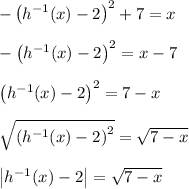If
 is the inverse of
is the inverse of
 , then
, then

Given that
 , we have
, we have

Solve for the inverse :

At this point, we have two possible solutions:
• If
 , then
, then
 . Continuing with the equation, we have
. Continuing with the equation, we have

• Otherwise, if
 , then
, then
 , in which case
, in which case

Both solutions are simultaneously incompatible. For instance, when x = 0 we have
 using the first solution, and
using the first solution, and
 using the second one. Choosing one over the other depends on how you restrict the domain.
using the second one. Choosing one over the other depends on how you restrict the domain.
(A) If we want to stick with the first solution, we would required that x ≥ 2. In other words, we would have
 defined only when x ≥ 2; then
defined only when x ≥ 2; then
 is defined only when
is defined only when
 , so that ...
, so that ...
(B) ... the inverse is

(C) The domain of the inverse is the same as the range of the original function, and vice versa.
• Domain: we have for all x that

so

which means the range of
 , and hence the domain of
, and hence the domain of
 , is
, is

• Range: we get this immediately from the domain restriction we chose earlier,

See the attached plot -
 is shown as a dashed orange curve;
is shown as a dashed orange curve;
 with the restricted domain is shown in blue; the inverse
with the restricted domain is shown in blue; the inverse
 corresponding to the restricted
corresponding to the restricted
 is shown in green; the other inverse is shown with a dashed red curve. You can see a geometrical properties of inverses: if you mirror the blue curve along the dotted line (y = x), you would get the green curve.
is shown in green; the other inverse is shown with a dashed red curve. You can see a geometrical properties of inverses: if you mirror the blue curve along the dotted line (y = x), you would get the green curve.